Today’s cannabidiol (CBD) market is extremely diverse. Because sellers face minimal restrictions, there’s a wide difference in quality and potency between different products. Buying high-quality CBD can be a confusing process for consumers, but it can be made easier by arming yourself with knowledge regarding the company and how their CBD was extracted.
A recent report drafted by LeafReport highlights some interesting trends in the CBD industry, regarding price, potencies, and products. The report covers over 3,500 products and 53 brands. It categorizes prices by bargain-grade, market-grade, and pricy, which were derived from the cost per milligram of CBD. Here are a few variables that can affect the quality and price.
Extraction Method
Extraction methods have different costs. According to the report, CO2 extractions tend to be costlier than ethanol extractions.
Testing
Some companies prove their CBD’s quality by working with independent laboratories. These labs provide reliable data that consumers can trust. This data costs the product manufacturer, though. A product lacking a certificate of analysis does not mean that it isn’t potent. However, you can use third-party information to help you find peace of mind, especially when a product is found to be devoid of contamination.
Organic
The organic craze has touched the CBD industry. Yet, it’s not viable for every company. As LeafReport notes: “In some states, there is no provision for certifying industrial hemp as organic. Lazarus Natural’s in Oregon, for instance, grows their products organically, follows the rules of the Oregon Farm Bureau, but still doesn’t provide organic certification.”
In states where hemp farmers can be certified organic, the process can be lengthy and expensive. Many product manufacturers, though, find the added expense to be worth it.
Much of the price difference between CBD products can be explained by the above reasons, but there are other factors at play as well. LeafReport found that the price variance between CBD tinctures was more than 1000%. It’s possible that many companies are inflating their prices because consumer demand is so high.
The study also found a whopping 3200% difference between lowest- and highest-priced products when the types of products were collectively grouped. The lowest were $0.02/mg while the highest was $0.66/mg.
Important for product design, the report summarizes the average potency and the range of potencies determined from the study. For example, the average potency of a topical product is 16.67 mg/mL, or 500 mg of CBD in a 30 mL (1 ounce) vessel. The most common capsule dosage is 25 mg, but the range spanned from 5 to 100 mg. Of course, when made from hemp extracts, the levels of delta-9-tatrahydrocannabinol might dictate the potency of the product, since it will need to be diluted to < 0.3%.
As a consumer, there is almost no way to judge a CBD product’s quality without doing your due diligence.
Image source: Health & Skin












